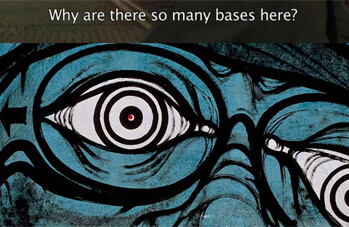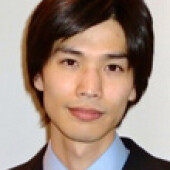To live in interesting times is a curse, according to the Chinese proverb. But for artists it may also be a blessing because their imaginations can be stimulated by social unrest and political upheaval. Anger, despair, and pain as well as a sense of solidarity and excitement are sometimes channeled into inspired creations. While artistic expression should not justify severe human suffering, since aesthetic considerations are subordinate to ethical concerns, the world would be aesthetically less lively if there were no suffering at all. We would not have Picasso's Guernica to appreciate had the Basque town not been bombed and destroyed in April 1937.
In modern Japan, 1960 was a year of extraordinary social and political disorder, with a series of mass demonstrations against the ratification of the U.S.-Japan Treaty of Mutual Cooperation and Security, signed in January 1960 in Washington, D.C. by then Prime Minister Nobusuke Kishi. The 1960 treaty was a revision of the U.S.-Japan Security Treaty that had been signed in 1951 while Japan was under occupation by the U.S.-led Allied forces. "Anpo" is the abbreviated Japanese term standing for both treaties, and it also refers to various protest movements against them.
Like all mass movements, the 1960 protest encompassed a wide range of voices, including nationalistic anti-American sentiments, a demand for stronger democratic accountability, and hostility toward Prime Minister Kishi (a former suspect of "Class A" war crimes who had been released from Sugamo Prison and depurged in accordance with the U.S. government's desire to work with the Japanese rightwing to combat the spread of communism in East Asia). To the dismay of the protesters and the relief of Kishi's realpolitik supporters, the new security treaty was ratified and enacted in June 1960. Reaffirmed ten years later, it remains the foundation for the so-called "Pacific Alliance."
Despite its ultimate failure, the 1960 protest was not a disaster for Japanese radical democrats. On the contrary, 1960 is often seen as a kind of "Jasmine" moment, a manifestation of growing democratic culture in what had been a militarist country until just 15 years prior. Nor was the ratification of the new treaty a triumph for conservatives. The prime minister announced his resignation on the very day the treaty was enacted, as he "felt strongly the need for a fresh public atmosphere."
The new film ANPO: Art X War is a cinematic portrait of the security treaty and the 1960 protest and what these stand for symbolically: the love-hate relationship between Japan and the United States, and the frustration of Japanese democrats with their imperfect democracy. The film tells this story through the artworks of those whose lives have been influenced by anpo. Historians and journalists appear in the film to give some basic factual information, but most of the interviews consist of artists telling how anpo-related events have inspired their works. The film features young artists such as Sachiko Kazama, born in 1972 to an ex-activist father, as well as first-hand participants in the 1960 protest such as painter Tadanori Yokoo, singer Tokiko Kato, and actor and director Kazuyoshi Kushida.
ANPO is thus not an explanatory film aiming at impartiality. Rather than telling a chronological narrative or offering a social scientific analysis, it freely moves from one artwork to another, from the personal to the political and from the past to the present, mentioning various issues whose relevance to the security treaty or the 1960 protest is sometimes obscure. The result is quite original and rather remarkable. Instead of offering a coherent argument, ANPO invites each viewer to decode messages from a mass of information. It wisely mobilizes inconclusiveness in a way that philosophers and social scientists cannot do.
What is interesting about ANPO's approach is that viewers are led to ponder tangential issues that the filmmakers could not have possibly foreseen. For example, the film repeatedly shows 1960s protesters attacking kuni, an ambiguous Japanese term which refers variously to the country, homeland, state, or central government, and is also used as a generic term for the Tokyo power elite. There is an obvious echo with today's deep discontent over the DPJ and TEPCO responses to Fukushima. One may well wonder what has really changed since the "revolutionary" election in 2009 shifted power from the conservative LDP to the presumably reformist DPJ.
The film's lessons also transcend Japanese domestic issues and U.S.-Japan relations. Tim Weiner, author of Legacy of Ashes: The History of the CIA, reminds us in the film that the U.S. government was willing to cooperate with all sorts of unsavoury characters during the Cold War as long as they were anti-communist. One may relate this to the current debate over the prudence of Western policies in the Middle East. Was it wrong for Western leaders to negotiate with strongmen like Hosni Mubarak and Muammar Gaddafi to seek regional stability and national interests? Would it have been better for the West to reject them altogether; and then what would have followed? What should political leaders in liberal democracies do, and not do, to find optimal solutions in a world where ideal options seem out of reach?
Deeply personal stories also emerge in ANPO amid the more abstract discussions of U.S. global strategy and East Asian security. In a particularly touching scene, Okinawan photographer Mao Ishikawa shows a deep tension between her anger at the U.S. military and her motherly feelings toward one young U.S. soldier who had his grandmother's face tattooed on his shoulder to protect him in battle. Stories like this pit heart and mind against each other, making one sympathize with those whose political opinions one does not share.
ANPO is a subtle movie of conflicting ideas and mixed emotions. Its remarkable achievement is to enable viewers to appreciate complexity in some of the urgent issues the world needs to tackle.
ANPO: Art X War will screen at the Guggenheim Museum in New York from July through September 2011.




